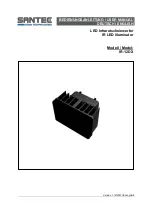
Faceplate
Chevron Cover
Red/Green Diffuser
Enclosure
Backplate
Wire Nuts
Junction Box
(Building Utility)
VEX SERIES
INSTALLATION INSTRUCTIONS
800.533.3948 • www.barronltg.com
10070040 Rev 6 - 11/18
Back Mounting
1. Remove faceplate and set aside.
2. Drill 3/8” hole into the center of the backplate (5). Drill 1/4” inch holes
into the oblong holes on backplate (5) that correspond to junction box
(7) being used.
3. Feed transformer leads through center hole of backplate.
4. Make electrical connections: see
Electrical Connection
section.
5. Feed excess wire into the junction box and secure backplate (5)
to the junction box (7) using screws (supplied by others).
6. For units without a battery door: connect the battery terminals
before securing the faceplate to the housing.
7. Remove diffuser (3) from inside of the faceplate (1) in order
to remove snap-in chevrons (2) as required. Store unused
chevron covers in a safe place. Then snap the faceplate (1)
to the housing (4).
8. For units with a battery door: after securing the faceplate
to the housing open the battery door and connect the battery
terminals. Close door and push the test button to confirm.
Allow to charge for 24 hours before the 90 minute test. Then
follow
Self-test/Self-diagnostics testing
section.
1
IMPORTANT SAFEGUARDS
READ AND FOLLOW ALL SAFETY INSTRUCTIONS.
When using electrical equipment, basic safety precautions should always be followed including the following:
DISCONNECT AC POWER SUPPLY BEFORE SERVICING.
• Installation and servicing of this equipment should be performed by qualified service personnel
• Ensure that the electrical wiring conforms to the National Electrical Code NEC® and local regulations if applicable.
• Do not mount near gas or electrical heaters.
• Equipment should be mounted in locations and at heights where it will not be readily subjected to tampering by
unauthorized personnel.
• For 2CI operation - ensure that both AC power and auxiliary power are not simultaneously live.
• The use of accessory equipment not recommended by the manufacturer may cause an unsafe condition.
• Any modification or use of non-original components will void the warranty and product liability.
• Do not use this equipment for other than intended use.
SAVE THESE INSTRUCTIONS!
Battery Door
























